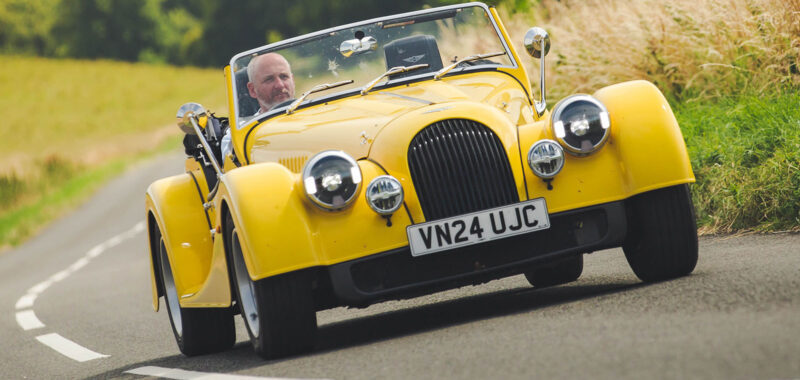You’re constantly adjusting and cajoling the Plus Four as you whisk it along, then. At a 60mph cruise on an A-road it needs regular little course corrections to account for its shifting mass and suspension deflection, and at fast B-road pace it requires a deliberate hand and plenty of concentration. On-centre steering feel is notably better if you drive the car in ‘S+’ mode, which is what most of our testers preferred.
Vertical body control on really testing surfaces is certainly loose enough to slow you down over bigger lumps and bumps and gives you plenty of pause for thought. This is a car that can feel oddly short on suspension travel; moreover, one that still seems to come up short on structural integrity and outright dynamic composure when really tested. At just the right speed, though, it rewards and engages in a disarmingly honest, simple way.
Driving this car quickly on Millbrook’s Hill Route is an undertaking that demands a bit of warming up to. With speed comes a heightened awareness of the Morgan’s fairly lax attitude to containing body roll through faster bends, as well as the really quite marked rear weight transfer that can accompany mid-corner applications of throttle.
It’s arguably in these instances where the Morgan is simultaneously at its most unsettling and exciting. As weight shifts rearwards, you feel the already mute steering go light, which makes sensing the point at which front-end grip becomes slip that much trickier. You often see the nose push wide before you feel it.
At the same time, your position out over the rear axle does mean you feel far more keyed in to any shimmies or slips on exit when you get it right, and the Morgan’s progressively geared steering provides decent scope for making those more minute, delicate corrections required to easily get things back in shape.
One important upgrade for 2024, though, is the new £1995 Dynamic Handling pack, which brings bespoke Nitron shocks, new springs that offer single-way damping and ride-height adjustment and a rear anti-roll bar.
It’s hard to imagine who was asking for such drastically improved poise and configurability, but the broader spread of characteristics it enables is welcome, as is the surprising agility that you can call on in more dynamically demanding situations.
You still wouldn’t see which way a Caterham Seven went, but there is a sense of sharpness here that belies the Plus Four’s Sunday morning billing. The steering bites with tenacity, gaining weight quickly, predictably and authentically as you tighten the angle, and the double-wishbone suspension and rear anti-roll bar do a nice job of keeping the body flat through fast bends.
You wonder whether a bit more lean and sponginess would better cement the Plus Four’s status as a top-down sun-seeker. Those new dampers go some way to boosting refinement, but it still creaks over speed bumps, crashes through potholes, judders over expansion joints and grumbles over rougher sections, making for less than languorous progress over all but the most pristine of roads. You find yourself weaving at speed to dodge imperfections; after a while you just slow down, relax and enjoy the view.
But ultimately, roof up or roof down, the Plus Four is not what anyone with working ears would call an isolated car. With some 84dB of noise in the cabin at a 70mph cruise, it was only 8db quiter than the completely open, windscreenless Ariel Atom 4.
There are equal amounts of road noise and wind intrusion evident as you drive, both out-shouting the car’s exhausts most of the time. With earplugs, it’s a noise level that you’d be willing to tolerate for reasonably extended periods. But quite clearly, when Morgan recommends a solid hard-top (which ought, at least, to better keep out the wind noise) to those who intend to drive their car frequently or to tour in it, it does so with good reason.

